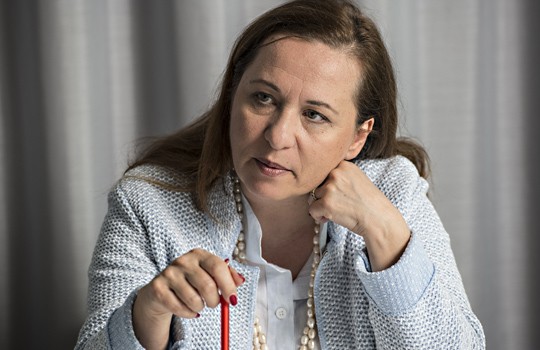FHNW Cloud Study 2018
“The Cloud needs new roles”
Companies are still unable to correctly assess the impacts of the Cloud. This year’s Cloud study by the University of Applied Sciences of Northwestern Switzerland (FHNW) demonstrates this. Lead researcher Stella Gatziu Grivas explains how decision makers can acquire this knowledge.
Text: Christoph Widmer, Images: Thomas Egli, 3 july 2018
Prof. Gatziu Grivas, what was the motivation for the Cloud study by FHNW?
In our CIO study last year, we also asked participants about Cloud maturity in their company. We wanted to find out how well prepared companies were to use Cloud technologies. Participants’ responses suggested there could be conflicting priorities between Business and IT departments regarding the Cloud. Departments often did not agree about the actual motivation and preparation for using the Cloud. In this year’s Cloud study, we wanted to focus on these points.

Prof. Stella Gatziu Grivas, Institute for Information Systems, FHNW
Did this impression turn out to be true?
Overwhelmingly, the main motivation for using the Cloud, as indicated by the majority of surveyed groups, was to reduce costs. Cloud providers themselves realise more than anyone that the Cloud is essential for digitally transforming their own companies. Among the other groups such as Business specialist managers, CIOs or even IT architects, this understanding is not widely shared yet.
“Only a few IT architects are aware of the impacts of the Cloud.”
Prof. Stella Gatziu Grivas, FHNW
The other study results demonstrate this: Only a few are really able to determine the impacts of the Cloud on business and IT processes. Were you surprised about this result?
Yes. I found it very surprising that only a few IT architects are aware of the impacts of the Cloud.
Why is that?
IT architects play an important role in the positioning of the Cloud. They know the data and business architecture and are familiar with the appropriate processes. They therefore have an important role in communicating the possibilities in using the Cloud. There is still little transparency in companies about this.
So, are IT architects not doing their jobs properly?
I think the entire subject of the Cloud has been regarded with blinkered vision. People have mainly only seen the risks in the Cloud. And if a potential is identified, it is overwhelmingly about cutting costs. This distorted view means that even today, the Cloud is not seen as a digital enabler across the entire company, even among IT architects. It’s easy to identify cost reductions. You compare today’s numbers with tomorrow’s. However, what is less tangible is when you are saving money, where you are reinvesting these savings and how the Cloud impacts on business. The statement “no digitisation without the Cloud” may sound like an advertising slogan. However, there is a great deal behind this. The Cloud is a complex matter.
A digitisation strategy which establishes the Cloud’s exact strategic positioning would clarify a lot here. Who should initiate this in the company?
Many CIOs said in our study from last year that they also see themselves in the role of the CDO. Consequently, many in IT management believe they are responsible for digitisation. They are right to view this as their task. The difficulty in this is appropriately communicating and implementing the digitisation strategy.
“The Journey to the Cloud brings with it an urgent need for companies to reorganise.”
Prof. Stella Gatziu Grivas, FHNW
How does this work?
The Cloud needs new roles. A company must establish exactly who is responsible for its Cloud strategy, who responds to Business requirements, or who, for example, demonstrates the potential of different Cloud-based solutions using technology scouting. The Journey to the Cloud therefore brings with it an urgent need for companies to reorganise. A consistent Cloud strategy therefore also needs a transformation roadmap, which establishes the new responsibilities. Both our studies show that this understanding does not yet exist in many companies.

What do IT have to do differently in the course of the Cloud transformation?
IT have to assume the new role of Cloud brokers. They manage the whole service catalogue and know the criteria which Cloud providers have to fulfil for their own Compliance and Governance specifications. As such, IT are responsible for implementing the digitisation and Cloud strategy and acting as a kind of link between Business and the Cloud. This way also prevents Business using Cloud Services without the involvement of IT, i.e. using shadow IT. The IT department has to integrate the new services and quickly realise whether the provider is suitable or not. This role is therefore central to Cloud transformation. Other roles, like the Sourcing Manager, the Cloud Lifecycle Manager or the Cloud Monitoring Manager are also part of this.
Is it thus already done with a restructured IT?
The approach is important. The Journey to the Cloud should not be understood to be a bottom-up approach whereby individual systems like CRM or ERP are just migrated to the Cloud. Anyone who limits themselves to individual services can miss opportunities. By contrast, anyone who follows a top-down strategy to gain a comprehensive overview of Cloud offerings will understand how they can most effectively use the Cloud in their company. As a result, they have to first obtain a comprehensive picture of the possibilities of the Cloud.
But that also applies to Business.
Absolutely. The top-down strategy must certainly be developed in collaboration with Business. But someone must take the lead.
The CIO?
It could be the CIO, but it could also be IT architects, specialist managers or people from the Management Board. Companies could also draw upon external expertise from Cloud providers as they are people who have strategically positioned themselves with the Cloud for a long time now. However, with a clear assignment.
What do you mean, exactly?
That Business and IT have also acquired the knowledge and not taken all the advice of an external consultant without thinking about it critically. Consultants have to be challenged in discussions. It’s not enough to rely solely on them. Companies have to do their homework.
Personal information
Stella Gatziu Grivas is a Professor at the Institute for Information Systems at the University of Applied Sciences of Northwestern Switzerland (FHNW) and Head of Competence Center Cloud Computing, Digitalisation & Transformation. She is on the board of EuroCloud Swiss and organises the FHNW Cloud Use Cases Days conference management.
More on the topic



